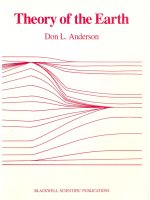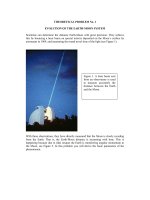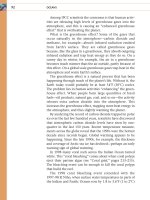Biomes of the earth taiga
Bạn đang xem bản rút gọn của tài liệu. Xem và tải ngay bản đầy đủ của tài liệu tại đây (18.59 MB, 241 trang )
BIOMES OF THE EARTH
TAIGA
Trevor Day
Illustrations by
Richard Garratt
Taiga
Copyright © 2006 by Trevor Day
All rights reserved. No part of this book may be reproduced or utilized in any form or by any
means, electronic or mechanical, including photocopying, recording, or by any information
storage or retrieval systems, without permission in writing from the publisher. For information
contact:
Chelsea House
An imprint of Infobase Publishing
132 West 31st Street
New York NY 10001
ISBN-13: 978-0-8160-5329-2
ISBN-10: 0-8160-5329-4
Library of Congress Cataloging-in-Publication Data
Day, Trevor.
Taiga / Trevor Day ; illustrations by Richard Garratt.
p. cm.—(Biomes of the Earth)
Includes bibliographical references and index.
ISBN 0-8160-5329-4
1. Taigas—Juvenile literature. I. Title. II. Series.
QH86.D39 2006
577.3’7—dc22
2005009791
Chelsea House books are available at special discounts when purchased in bulk quantities
for businesses, associations, institutions, or sales promotions. Please call our Special Sales
Department in New York at (212) 967-8800 or (800) 322-8755.
You can find Chelsea House on the World Wide Web at
Text design by David Strelecky
Cover design by Cathy Rincon
Illustrations by Richard Garratt
Photo research by Elizabeth H. Oakes
Printed in Hong Kong
CP Hermitage 10 9 8 7 6 5 4 3 2
This book is printed on acid-free paper.
From Richard Garratt:
To Chantal, who has lightened my darkness
CONTENTS
Preface
Acknowledgments
Introduction
xi
xv
xvii
CHAPTER 1
GEOGRAPHY OF THE TAIGA
What is taiga?
Where is taiga?
1
1
2
Why conifers?
4
Taiga landscapes
5
Dark and light taiga
Harsh survivors
North American taiga
Threats to Canada’s taiga
Pacific coast rain forest
European taiga
Conifer forests in European mountains
Scotland’s Caledonian Forest
Siberian taiga
The Tien Shan Mountains of central Asia
Far Eastern taiga
East Asia’s rare large mammals
6
6
7
10
11
12
13
14
15
17
17
20
CHAPTER 2
GEOLOGY OF THE TAIGA
Earth’s structure
North American landforms today
The work of glaciers
Taiga soils
Bogs, peat, and forest
Hidden history
Deadly pitchers
Permafrost
21
21
24
25
28
30
31
32
32
CHAPTER 3
TAIGA CLIMATE
Weather, climate, and atmosphere
What is radiation?
Solar heating and air movement
The effect of Earth’s rotation
Global air circulation
The changing seasons
North American taiga and the polar front
Air masses
The effect of the Great Lakes
36
36
38
39
40
42
44
45
46
49
Ocean currents and taiga
Snow
49
50
Taiga blizzards
Surviving supercooling
52
52
Taiga advance and retreat
Global warming and the taiga
The greenhouse effect
53
55
57
CHAPTER 4
TAIGA BIOLOGY
Dark or light taiga?
Dark conifers
What is a cone?
Light conifers
Broad-leaved trees of the taiga
Beneath the canopy
Death of a tree
Partners beneath the soil
Mosses and lichens
Sphagnum moss
Pollination and seed dispersal
Origins of the taiga animals
Taiga insects
Amphibians and reptiles
Bird life
Small mammals
59
59
59
60
62
63
65
67
68
69
71
71
72
73
75
76
80
A pale shadow
81
Large mammals
83
Wood bison
Salmon feast
86
89
CHAPTER 5
TAIGA ECOLOGY
Energy flow, food chains, and food webs
Types of symbiosis
Renewal and succession
Fire in the taiga
Fire shapes the taiga
Animals surviving winter
Size matters
Migrations
Predator-prey cycles
91
91
95
95
97
98
100
102
103
104
CHAPTER 6
THE TAIGA IN HISTORY
AND PREHISTORY
Origins of taiga peoples
The Bering land bridge (Beringia)
The first Americans
Siberian hunters
Traditional codes of conduct
Hunters and fishers
The modern North American taiga
Using cedar and birch
Totems and totem poles
Taiga medicine
The modern Eurasian taiga
Meeting today’s challenges
106
107
108
110
112
114
115
116
117
118
119
120
123
CHAPTER 7
USES OF THE TAIGA
Hunting and fur farming
Fur farms
Sable fur
Taiga tree products
The timber, pulp, and paper industries
Christmas trees
Forestry
125
126
127
128
128
131
132
133
Annual allowable cut
136
Agriculture
Hydroelectric power
136
137
Fishing
Mining
Uranium City
The mixed economy
138
139
141
142
CHAPTER 8
THREATS TO THE TAIGA
Overhunting
Habitat change, habitat loss
Clear-cutting
The Great Bear Rainforest
Fragmentation
Fires
Introductions of exotic species
Hydroelectricity
Air pollution
Acidity and acid rain
Mining, oil and gas, and pulp and paper industries
Climate change
CONCLUSION:
MANAGING THE TAIGA
Mapping a forest
Forests and freshwater
The age of Canada’s trees
Biodiversity
Endangered species in Canada’s taiga
Maintaining genetic diversity
The world’s biggest clone?
Tree harvesting
Assisting forest regeneration
Fire as a management tool
Controlling forest pests
Protected areas
The future demand for wood
Certification
Taiga: carbon sink or carbon source?
144
144
145
146
148
148
149
150
151
153
156
158
161
164
164
165
169
169
172
174
175
176
178
179
180
181
183
184
185
Accommodating alternative views of the taiga
A local mixed economy
Glossary
Further reading
Web sites
Index
187
189
193
201
203
207
PREFACE
Earth is a remarkable planet. There is nowhere else in our
solar system where life can survive in such a great diversity of
forms. As far as we can currently tell, our planet is unique.
Isolated in the barren emptiness of space, here on Earth we
are surrounded by a remarkable range of living things, from
the bacteria that inhabit the soil to the great whales that
migrate through the oceans, from the giant redwood trees of
the Pacific forests to the mosses that grow on urban sidewalks. In a desolate universe, Earth teems with life in a bewildering variety of forms.
One of the most exciting things about the Earth is the rich
pattern of plant and animal communities that exists over its
surface. The hot, wet conditions of the equatorial regions
support dense rain forests with tall canopies occupied by a
wealth of animals, some of which may never touch the
ground. The cold, bleak conditions of the polar regions, on
the other hand, sustain a much lower variety of species of
plants and animals, but those that do survive under such
harsh conditions have remarkable adaptations to their testing environment. Between these two extremes lie many
other types of complex communities, each well suited to the
particular conditions of climate prevailing in its region. Scientists call these communities biomes.
The different biomes of the world have much in common
with one another. Each has a plant component, which is
responsible for trapping the energy of the Sun and making it
available to the other members of the community. Each has
grazing animals, both large and small, that take advantage of
the store of energy found within the bodies of plants. Then
come the predators, ranging from tiny spiders that feed upon
even smaller insects to tigers, eagles, and polar bears that survive by preying upon large animals. All of these living things
XI
XII
TAIGA
form a complicated network of feeding interactions, and, at
the base of the system, microbes in the soil are ready to consume the energy-rich plant litter or dead animal flesh that
remains. The biome, then, is an integrated unit within which
each species plays its particular role.
This set of books aims to outline the main features of each
of the Earth’s major biomes. The biomes covered include the
tundra habitats of polar regions and high mountains, the
taiga (boreal forest) and temperate forests of somewhat
warmer lands, the grasslands of the prairies and the tropical
savanna, the deserts of the world’s most arid locations, and
the tropical forests of the equatorial regions. The wetlands of
the world, together with river and lake habitats, do not lie
neatly in climatic zones over the surface of the Earth but are
scattered over the land. And the oceans are an exception to
every rule. Massive in their extent, they form an interconnecting body of water extending down into unexplored
depths, gently moved by global currents.
Humans have had an immense impact on the environment of the Earth over the past 10,000 years since the last Ice
Age. There is no biome that remains unaffected by the presence of the human species. Indeed, we have created our own
biome in the form of agricultural and urban lands, where
people dwell in greatest densities. The farms and cities of the
Earth have their own distinctive climates and natural history,
so they can be regarded as a kind of artificial biome that people have created, and they are considered as a separate biome
in this set.
Each biome is the subject of a separate volume. Each richly
illustrated book describes the global distribution, the climate,
the rocks and soils, the plants and animals, the history, and
the environmental problems found within each biome.
Together, the set provides students with a sound basis for
understanding the wealth of the Earth’s biodiversity, the factors that influence it, and the future dangers that face the
planet and our species.
Is there any practical value in studying the biomes of the
Earth? Perhaps the most compelling reason to understand
the way in which biomes function is to enable us to conserve
their rich biological resources. The world’s productivity is the
PREFACE
basis of the human food supply. The world’s biodiversity
holds a wealth of unknown treasures, sources of drugs and
medicines that will help to improve the quality of life. Above
all, the world’s biomes are a constant source of wonder,
excitement, recreation, and inspiration that feed not only
our bodies but also our minds and spirits. These books aim to
provide the information about biomes that readers need in
order to understand their function, draw upon their
resources, and, most of all, enjoy their diversity.
XIII
ACKNOWLEDGMENTS
I would like to thank the team that helped create this book:
illustrator Richard Garratt, picture researcher Elizabeth
Oakes, project editor Dorothy Cummings, and executive editor Frank Darmstadt, who commissioned and managed the
project. A final thank you to my partner Christina, who is
unswerving in encouraging me and my work.
XV
INTRODUCTION
A biome is a major ecological zone on Earth’s surface. Scientists normally define a biome by the community of plants
within it. The plants, in turn, dictate which kinds of animals
live there. The plant community reflects the nature of the
soil conditions and the prevailing climate. Hot deserts contain plants and animals that are adapted to high temperatures and scarcity of water. Tropical rain forest organisms, on
the other hand, thrive at similar temperatures but where
rainfall is much higher. Boreal forest, or taiga, the subject of
this book, is the biome defined by its northerly distribution
and its abundance of conifer trees (trees with needles instead
of broad leaves and cones instead of flowers).
Most biologists recognize about 10 biomes, all but one of
which are found on land. The biomes include taiga or boreal
forest (northern forests of conifer trees), temperate forest
(hardwoods, or mixed forests of hardwoods and conifers),
tropical rain forest, tropical seasonal forest, desert, alpine
(mountains), grassland, wetland, and tundra. The ocean
biome is unlike all the others. It spans all climates, from icy
polar waters to warm tropical seas.
Chapter 1 of this book explores the geography of the taiga.
It explains what taiga is, where it is found, and why it is
found there. It describes typical taiga landscapes and then
considers the world’s four taiga regions: North American,
European, Siberian, and Far Eastern.
Chapter 2 reveals the geology of the taiga. It explains how
the bedrock beneath the Canadian taiga has been shaped by
the movement of Earth’s plates and then sculpted by glaciers. The chapter describes taiga soils and permafrost (permanently frozen ground) and its influence on soil structure
and plant life.
XVII
XVIII
TAIGA
Chapter 3 considers taiga’s weather and climate. The
Earth’s changing climate influences the nature and distribution of the taiga. Human activities appear to be accelerating
global climate change.
As chapter 4 explains, the assemblage of animals and
plants that thrive in the taiga is smaller—in variety and
abundance—than in most other biomes. Chapter 5 considers
ecological processes that govern the lives of taiga’s organisms.
Chapter 6 chronicles the origins of taiga’s peoples and
reveals how they have adapted to the unique set of conditions in the boreal forest. Their experience provides some
insight into how and why the taiga should be valued.
As chapter 7 also makes clear, the taiga provides many
products and services, some of which are taken entirely for
granted by people living outside the biome. Traditional taiga
lifestyles based on hunting, fishing, and gathering have been
joined by the working practices of modern forestry, agriculture, and mining industries. These industries are powered, in
some cases, by electricity from hydroelectric systems. Today,
traditional and modern methods for exploiting taiga’s
resources often exist side by side in a mixed economy.
The activities of people have removed or altered much of
the world’s taiga, and they continue to do so today. As chapter 8 explains, people have depleted many of taiga’s animal
populations through overhunting and overfishing. Clearcutting of forests, followed by changes in land use, has substantially altered the area of taiga in the last 2,000 years.
Those large forests that remain are becoming increasingly
fragmented. Human activities have altered the boreal forest
by introducing foreign species of plant and animal, creating
air and water pollution, and flooding the land. Most pervasive of all are the effects of human-induced climate change.
To manage the taiga effectively, we first need to know what
is there. The last chapter explains how modern survey methods, ranging from remote sensing from a satellite or aircraft
to monitoring the age and health of individual trees, are revolutionizing our understanding of the taiga. A range of
strategies, from forest regeneration and the controlled use of
fire to creating protected areas and conserving genetic diver-
INTRODUCTION
sity, seeks to manage the taiga in a sustainable manner. The
taiga has a key role to play in climate warming, a process that
is changing the nature and distribution of the world’s northern forests. If we are to conserve the taiga, then we need to
understand how its biological processes work and manage
these northern forests with a lighter and wiser touch than we
do at present.
The two greatest expanses of taiga lie in Canada and Russia. More examples are provided from the Canadian experience because, for the moment, the quantity and quality of
their readily available information, and its ease of interpretation, is generally greater.
XIX
CHAPTER 1
GEOGRAPHY OF THE TAIGA
The chilling, distant howl of a wolf, the staccato hammering
of a woodpecker nearby, the bounce of the dense carpet of
conifer needles underfoot. The shaft of pure light slicing
through the canopy of tall, dark, brooding trees. The crisp air
rich with resinous fragrance. These are some of the sensory
impressions any visitor to the great north woods can experience. This is the taiga.
What is taiga?
The word taiga originates from northern Russia, where it
was originally used to describe the dense woodlands of
spruce—a type of conifer tree—found in cool, wet climates.
In the 20th century, the term came to include all cool,
northern coniferous forests, including the so-called boreal
forests of North America and Europe (from the Latin Boreas,
the god of the north wind). Some researchers also refer to
the coniferous forest of the mountains of warm temperate
regions as taiga. Some of these mountain forests, such as
those of the Alps in Europe and the Appalachians and the
southern Rockies in the United States, are mentioned in
this volume but are described more fully in other volumes
in the series.
Climatic conditions in the taiga environment are cool and
wet. The winters tend to be long and severe, with up to six
months of the year having average daily temperatures below
freezing. The summers are short, often with fewer than 100
frost-free days, and this produces a characteristically short
growing season. A growing season of about three months or
less distinguishes taiga from other types of lowland, coniferous forest found in more southerly latitudes of the Northern
Hemisphere, such as the pine forests of Italy and Spain,
1
2
The beauty of the taiga.
Dense conifer forest
surrounding a lake
in Denali National
Park, Alaska. Subtle
differences in soil type
and climate produce
variations in the sizes
and types of trees found
between the edge of the
lake in the foreground
and the base of the
mountains in the
distance. (Courtesy of
Tom Mangelsen/
Minden Pictures)
TAIGA
where temperatures are warmer and the growing season
longer. In the Southern Hemisphere, there are also forests of
conifers (albeit very different species), but these, too, are
found in warmer climates. In the Southern Hemisphere, in
the latitudes where taiga might be found—between about 45°
and 70° latitude—the Earth’s surface is mostly covered by
ocean. Hence, there is no comparable forest to taiga in the
Southern Hemisphere.
Conifer trees dominate the taiga. They are members of
the group of seed-bearing plants that belong to the class
Gymnospermae (meaning “naked seeds”), the gymnosperms. They have needlelike leaves and bear cones instead
of flowers. Most of taiga’s conifers belong to four groups:
spruces (genus Picea), firs (Abies), pines (Pinus), and larches,
or tamaracks (Larix). All except the larches are evergreen
(they keep most of their leaves year-round). Larches are
deciduous—they periodically shed their leaves, usually in
winter.
Where is taiga?
According to some biologists, taiga covers about 11 percent
of the Earth’s land surface, an area similar to that occupied by
hot desert and arguably larger than that covered by tropical
rain forest. Experts do not agree on the precise extent of the
world’s biomes because they use different criteria to identify
the exact borders of each.
GEOGRAPHY OF THE TAIGA
3
pointed apex
conical arrangement of branches
cones and
needlelike leaves
straight trunk with lower section
devoid of branches
The typical features of a
conifer tree
The main lowland zone of taiga lies between latitudes of
about 70°N and 45°N at its extremes, with most of the biome
situated between about 60°N and 50°N. Taiga forms an
almost continuous belt of forest across landmasses, from the
Pacific coast of Canada and the United States in the west to
the Pacific shores of Siberia and as far east as Kamchatka and
northern Japan. This belt is interrupted in northwest Europe,
where the North Atlantic Drift warms the climate and true
taiga is more localized. Over many hundreds of years, people
clearing the forest for fuel and to create space for agricultural
crops or livestock farming have removed most of the taiga in
Scotland and parts of Scandinavia.
Taiga is bordered to the north by tundra—treeless plains
of moss, lichen, heather, dwarf shrubs, and tough grasses.
4
TAIGA
Why conifers?
Why are conifers the dominant trees of the taiga? The answer lies in the handful of
adaptations that enable conifers to cope with the cold, the snow, and the lack of available water. Although water is abundant throughout the year, for many months it is
locked in ice.
■
■
■
Most conifers are conical in overall shape, with their branches angled slightly
downward. Snow, rather than settling on the leaves and snapping branches,
tends to slide off.
The needle leaves have a thick, waxy coating and a small area of surface. This
reduces their tendency to lose water by evaporation. This is particularly important in winter, when the ground is frozen and the trees cannot replenish water
they lose by taking in fresh supplies through their roots.
Most conifers are evergreens. This means they can use their leaves to photosynthesize (make food using trapped sunlight energy) as soon as temperatures warm. Unlike deciduous trees, they do not have to wait to grow a new
set of leaves at the start of the short growing season before they can photosynthesize.
Here, temperatures rise above 50°F (10°C) for only a few
weeks in the year, and the available sunlight supports only
a short growing season—too short for full-size trees to
grow.
The taiga-tundra boundary is a transitional zone, called an
ecotone, where treeless tundra gives way only gradually to
dense, coniferous forest. Here, clumps of trees are interspersed by patches of tundra. Where sheltered valleys extend
into the tundra, conifers hug the valley sides. Within the
taiga, where the ground is too damp or too cold and windexposed to support tree growth, tundra-like conditions exist
in isolated pockets.
The southern border of the taiga, like its northern counterpart, is an ecotone. Moving south from dense taiga, coniferdominated forest gradually gives way to mixed conifer and
broad-leaved forest, to almost pure broad-leaved forest, or to
temperate grassland.









